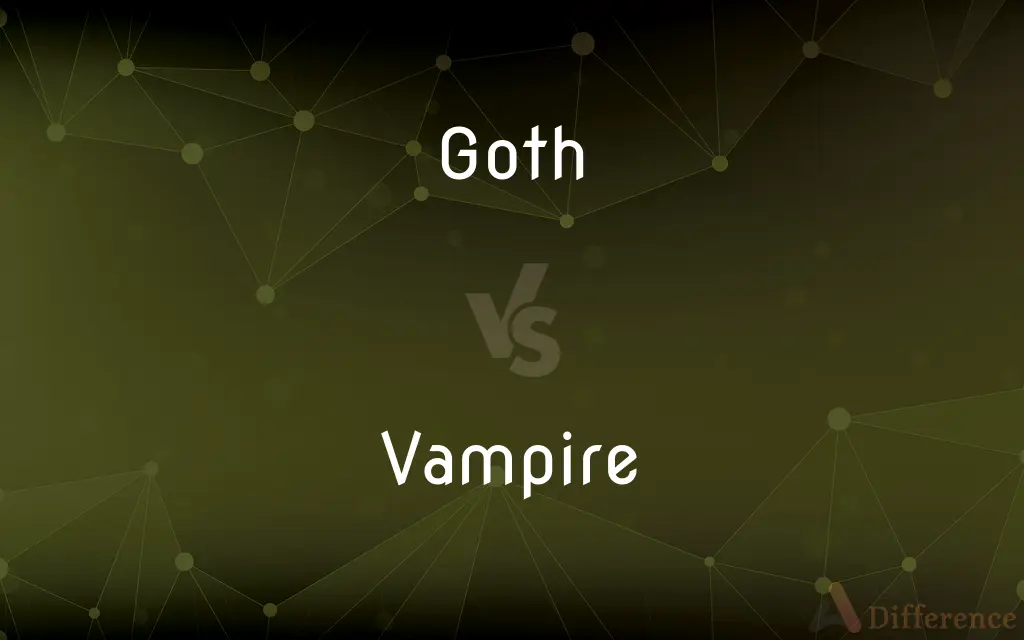Goth vs. Vampire — What's the Difference?
By Maham Liaqat & Urooj Arif — Updated on April 17, 2024
Goth is a subculture marked by dark aesthetics and music, while vampires are mythical beings known for drinking blood and immortality.

Difference Between Goth and Vampire
Table of Contents
ADVERTISEMENT
Key Differences
Goth culture primarily revolves around a specific music and fashion style characterized by dark, often melancholic aesthetics, while vampires are creatures from folklore that have become iconic figures in popular culture due to their association with immortality and a thirst for blood.
Goths often express themselves through gothic rock, post-punk, and other music genres that emphasize sorrowful and brooding tones, whereas vampires are typically depicted in media as having supernatural powers and a predatory nature towards humans.
The goth subculture includes a variety of fashion styles such as Victorian-inspired clothing, dark makeup, and elaborate hairdos, on the other hand, vampires are often portrayed wearing timeless, often aristocratic attire that reflects their origins from different historical periods.
Socially, goths might gather at concerts, clubs, and festivals celebrating their unique subculture, whereas vampires are often shown in stories as solitary beings or part of secretive vampire societies hidden from human awareness.
Goth subculture encourages individual expression and may involve various artistic pursuits including music, literature, and visual arts, whereas the mythos surrounding vampires often explores themes of morality, immortality, and human conflict.
ADVERTISEMENT
Comparison Chart
Definition
A subculture with a distinct style in music and fashion
Mythical beings who drink blood and may be immortal
Music/Fashion
Includes gothic rock, dark aesthetics, and elaborate attire
Often depicted with timeless, aristocratic clothing
Cultural Activity
Attends concerts, clubs, and festivals
Featured in folklore and popular media as part of hidden societies
Themes
Individual expression, darkness in aesthetics
Immortality, predation, secrecy
Representation
Real people partaking in a lifestyle
Fictional characters in horror and fantasy genres
Compare with Definitions
Goth
Pertaining to gothic rock and post-punk music.
The club night featured a goth theme with bands like The Cure playing.
Vampire
Often depicted as immortal and living in secrecy.
The ancient vampire had lived through centuries unnoticed.
Goth
Someone who appreciates the darker, melancholic themes in art and music.
He is a goth who loves listening to Bauhaus and Siouxsie Sioux.
Vampire
A character in folklore and popular media associated with horror.
Vampires are a popular subject during Halloween because of their spooky nature.
Goth
Associated with gothic literature and romanticism.
As a goth, she enjoyed reading Edgar Allan Poe and Ann Radcliffe.
Vampire
Symbolizing seduction and danger in narratives.
The vampire seduced his victims before revealing his true nature.
Goth
Related to dark, mysterious fashion styles.
Her goth attire included lace gloves and a corset.
Vampire
A mythical creature that drinks blood and has supernatural powers.
The vampire in the story could turn into a bat at will.
Goth
A member of a subculture that enjoys dark music and fashion.
She dressed as a goth with black lipstick and a velvet gown.
Vampire
Represented with specific weaknesses such as sunlight and garlic.
In the movie, the vampire was defeated using a garlic-laden trap.
Goth
A member of a Germanic people who invaded the Roman Empire in the early centuries of the Christian era.
Vampire
A vampire is a creature from folklore that subsists by feeding on the vital essence (generally in the form of blood) of the living. In European folklore, vampires are undead creatures that often visited loved ones and caused mischief or deaths in the neighbourhoods they inhabited while they were alive.
Goth
A style of rock music, noted especially for somber or ethereal tones and lugubrious lyrics.
Vampire
In popular folklore, an undead being in human form that survives by sucking the blood of living people, especially at night.
Goth
A performer or follower of this style of music.
Vampire
A person, such as an extortionist, who takes advantage of others, especially for personal gain.
Goth
(uncountable) A punk-derived subculture of people who predominantly dress in black, associated with mournful music and attitudes.
Philip has been into goth for many years, haven't you dear?
Vampire
A vampire bat.
Goth
A style of punk rock influenced by glam rock; gothic rock.
Vampire
A mythological undead creature said to feed on the blood of the living.
Goth
(countable) A person who is part of the goth subculture.
We saw a solitary goth hanging out on a ledge by the train station.
Vampire
(colloquial) A person with the medical condition systemic lupus erythematosus, colloquially known as vampirism, with effects such as photosensitivity and brownish-red stained teeth.
Goth
Relating to goth music or people.
With her black clothes and dyed hair, Melanie looked very goth compared to her classmates.
Vampire
A blood-sucking bat; vampire bat (Desmodus rotundus)
Goth
One of an ancient Teutonic race, who dwelt between the Elbe and the Vistula in the early part of the Christian era, and who overran and took an important part in subverting the Roman empire.
Vampire
A person who drains one's time, energy, money, etc.
Goth
One who is rude or uncivilized; a barbarian; a rude, ignorant person.
Vampire
(dated) A vamp: a seductive woman who exploits men.
Goth
A crude uncouth ill-bred person lacking culture or refinement
Vampire
A medical technician who works with patients' blood.
Goth
One of the Teutonic people who invaded the Roman Empire in the 3rd to 5th centuries
Vampire
Synonym of anti-ship missile(ASM), particularly an incoming hostile one.
Vampire. Vampire. Vampire. Battle stations.
Vampire
To drain of energy or resources.
Vampire
A blood-sucking ghost; a soul of a dead person superstitiously believed to come from the grave and wander about by night sucking the blood of persons asleep, thus causing their death. This superstition was once prevalent in parts of Eastern Europe, and was especially current in Hungary about the year 1730. The vampire was often said to have the ability to transform itself into the form of a bat, as presented in the novel depicting the legend of Dracula published by Bram Stoker in 1897, which has inspired several movies.
The persons who turn vampires are generally wizards, witches, suicides, and persons who have come to a violent end, or have been cursed by their parents or by the church,
Vampire
Fig.: One who lives by preying on others; an extortioner; a bloodsucker.
Vampire
Either one of two or more species of South American blood-sucking bats belonging to the genera Desmodus and Diphylla; also called vampire bat. These bats are destitute of molar teeth, but have strong, sharp cutting incisors with which they make punctured wounds from which they suck the blood of horses, cattle, and other animals, as well as man, chiefly during sleep. They have a cæcal appendage to the stomach, in which the blood with which they gorge themselves is stored.
Vampire
Any one of several species of harmless tropical American bats of the genus Vampyrus, especially Vampyrus spectrum. These bats feed upon insects and fruit, but were formerly erroneously supposed to suck the blood of man and animals. Called also false vampire.
Vampire
(folklore) a corpse that rises at night to drink the blood of the living
Common Curiosities
How do goths express their subculture?
Goths express their subculture through unique fashion, music, and attending related social events.
What defines someone as a goth?
Being a goth involves embracing a subculture centered on dark aesthetics in music and fashion.
What is a common misconception about goths?
A common misconception is that all goths are involved in dark magic or occult practices.
What kind of music do goths listen to?
Goths often listen to gothic rock, post-punk, and darkwave music.
What defeats a vampire in folklore?
Common ways to defeat vampires in folklore include exposure to sunlight, stakes through the heart, and holy water.
What is the origin of vampire myths?
Vampire myths originate from various cultures around the world, each adding unique attributes to the vampire legend.
How do vampires sustain themselves?
Vampires typically sustain themselves by drinking human or animal blood.
Is goth fashion the same worldwide?
While goth fashion has core elements like dark clothing and makeup, it can vary greatly in detail around the world.
What are typical characteristics of a vampire?
Vampires are characterized by their need to drink blood, immortality, and certain supernatural abilities.
Can anyone become a goth?
Yes, anyone can adopt the goth subculture by aligning with its fashion, music, and cultural aspects.
Are vampires real or fictional?
Vampires are fictional and originate from folklore and popular culture.
Do vampires age?
In most stories, vampires do not age and are considered immortal.
Why are vampires often portrayed as aristocratic?
Vampires are often portrayed as aristocratic to highlight their longevity and historical presence through various eras.
What is the difference between goth and emo?
Goth and emo both share a love for dark aesthetics, but emo focuses more on emotional expression and has distinct musical influences like punk rock.
What do goths value in their subculture?
Goths value artistic expression, individualism, and a community that shares an appreciation for the aesthetic and emotional depth of the dark and macabre.
Share Your Discovery

Previous Comparison
Staycation vs. Vacation
Next Comparison
Yogurt vs. DahiAuthor Spotlight
Written by
Maham LiaqatCo-written by
Urooj ArifUrooj is a skilled content writer at Ask Difference, known for her exceptional ability to simplify complex topics into engaging and informative content. With a passion for research and a flair for clear, concise writing, she consistently delivers articles that resonate with our diverse audience.















































